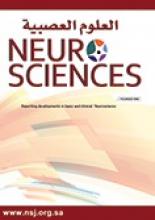Abstract
Absent F wave in the stage of spinal shock has been described in cases of traumatic spinal cord injury. The role of F wave in predicting prognosis after conus medullaris infarct has not been described. We describe herein a middle aged-man with a conus medullaris infarct. Both tibial and peroneal F waves were absent on day 4. The left tibial F wave reappeared in the following study on day 18. All F waves reappeared on day 56 at which time the patient was still wheelchair bound. He regained walking on day 105. We hypothesize that reappearance of initially absent F waves post conus medullaris infarct is a good prognostic sign for the return of ambulation. The applicability of this observation requires further research. We also discuss clinical and diagnostic caveats in this case.
Footnotes
Disclosure
The author has no conflict of interest and the work was not supported by or funded by any drug company.
- Received August 27, 2015.
- Accepted March 9, 2016.
- Copyright: © Neurosciences
Neurosciences is an Open Access journal and articles published are distributed under the terms of the Creative Commons Attribution-NonCommercial License (CC BY-NC). Readers may copy, distribute, and display the work for non-commercial purposes with the proper citation of the original work.






